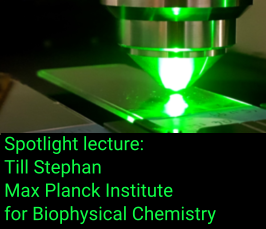Investigation of the mitochondrial inner membrane architecture using super-resolution light and electron microscopy
Spotlight Talk
- Date: Dec 10, 2020
- Time: 03:30 PM (Local Time Germany)
- Speaker: Till Stephan
- PhD student at the The Max Planck Institute for Biophysical Chemistry in Göttingen
- Location: web-talk
- Room: Zoom-Meeting
- Host: Max Planck BioImaging Core Unit Network - Spotlight Talks

Till Stephan will talk about two publications:
MICOS assembly controls mitochondrial inner membrane remodeling and crista junction redistribution to mediate cristae formation
Mitochondrial function is critically dependent on the folding of the mitochondrial inner membrane into cristae; indeed, numerous human diseases are associated with aberrant crista morphologies. With the MICOS complex, OPA1 and the F1Fo-ATP synthase, key players of cristae biogenesis have been identified, yet their interplay is poorly understood. Harnessing super?resolution light and 3D electron microscopy, we dissect the roles of these proteins in the formation of cristae in human mitochondria. We individually disrupted the genes of all seven MICOS subunits in human cells and re?expressed Mic10 or Mic60 in the respective knockout cell line. We demonstrate that assembly of the MICOS complex triggers remodeling of pre?existing unstructured cristae and de novo formation of crista junctions (CJs) on existing cristae. We show that the Mic60?subcomplex is sufficient for CJ formation, whereas the Mic10?subcomplex controls lamellar cristae biogenesis. OPA1 stabilizes tubular CJs and, along with the F1Fo-ATP synthase, fine?tunes the positioning of the MICOS complex and CJs. We propose a new model of cristae formation, involving the coordinated remodeling of an unstructured crista precursor into multiple lamellar cristae.
Multicolor 3D MINFLUX nanoscopy of mitochondrial MICOS proteins
The mitochondrial contact site and cristae organizing system (MICOS) is a multisubunit protein complex that is essential for the proper architecture of the mitochondrial inner membrane. MICOS plays a key role in establishing and maintaining crista junctions, tubular or slit-like structures that connect the cristae membrane with the inner boundary membrane, thereby ensuring a contiguous inner membrane. MICOS is enriched at crista junctions, but the detailed distribution of its subunits around crista junctions is unclear because such small length scales are inaccessible with established fluorescence microscopy. By targeting individually activated fluorophores with an excitation beam featuring a central zero-intensity point, the nanoscopy method called MINFLUX delivers single-digit nanometer-scale three-dimensional (3D) resolution and localization precision. We employed MINFLUX nanoscopy to investigate the submitochondrial localization of the core MICOS subunit Mic60 in relation to two other MICOS proteins, Mic10 and Mic19. We demonstrate that dual-color 3D MINFLUX nanoscopy is applicable to the imaging of organellar substructures, yielding a 3D localization precision of ~5 nm in human mitochondria. This isotropic precision facilitated the development of an analysis framework that assigns localization clouds to individual molecules, thus eliminating a source of bias when drawing quantitative conclusions from single-molecule localization microscopy data. MINFLUX recordings of Mic60 indicate ringlike arrangements of multiple molecules with a diameter of 40 to 50 nm, suggesting that Mic60 surrounds individual crista junctions. Statistical analysis of dual-color MINFLUX images demonstrates that Mic19 is generally in close proximity to Mic60, whereas the spatial coordination of Mic10 with Mic60 is less regular, suggesting structural heterogeneity of MICOS.